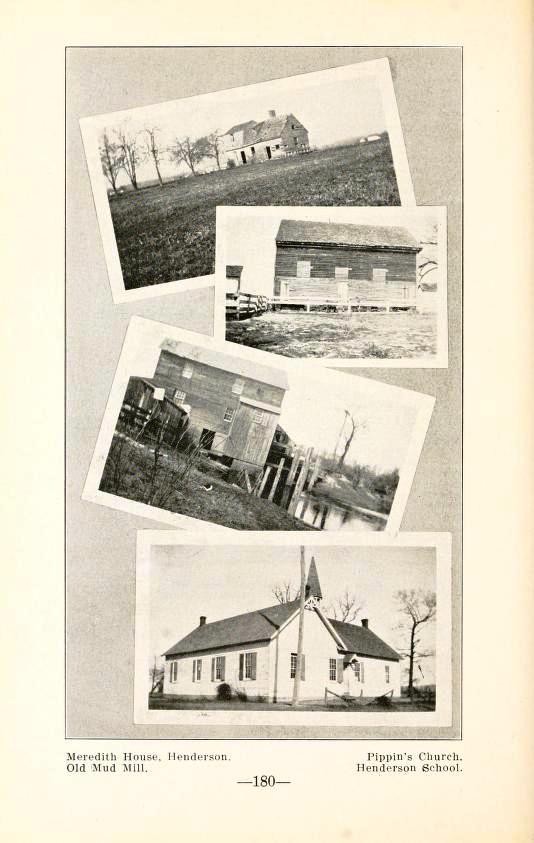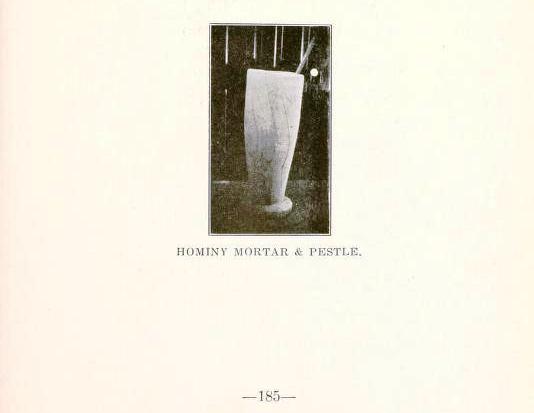The History of Caroline County, Maryland, From Its Beginning
Henderson Locality

Arrow heads, stones, axes, and other Indian relics have been found in the gardens and fields of our neighborhood, so we know that long ago Indians lived where we live today.
The many paths through the forests proved that rabbits, raccoons, opossums, squirrels, foxes, deer, and bears were once plentiful; but there came a time when pioneers came and made it necessary for the Indians, and the larger animals to move farther inland; and there came a time when our village began and this is the way it happened.
At the close of the eighteenth century there was a man by the name of Edward Thawley who owned the little farm now known as "The Carmine Place" or "The Carrow Place."
A widowed daughter, a Mrs. Patrick, with several children, came to live with her father, Edward Thawley. Among these grand children was one very amiable maiden named Elizabeth Patrick. About 1831 a young man from Delaware, Joshua Meredith, came a wooing this Elizabeth Patrick and in 1833 they were married in Busic's Church. Their first home was on the farm now owned by Alonzo Cohee .
When Edward Thawley died this Joshua and Elizabeth Meredith came into possession of his little farm, and in 1849 they built the house which now stands on this land.
The cross roads in our town was first called Meredith's Crossing for this family of Meredith's.
Joshua Meredith died 1851. In 1880 Elizabeth Meredith married John Wesley Carmine, and they continued to reside in her old home. Mr. Carmine died in 1891. Mrs. Carmine died July 6, 1899. They were buried in the "Gibson Burying Ground," which is on Mrs. Elizabeth Dill's farm near Henderson.
The name Henderson was given to the town in 1868 for a Mr. Henderson who was a stockholder or director of the Delaware and Chesapeake Railroad.
The first two houses in our village were built in 1866 for Joseph Wilson, who for many years resided in Barclay. The store now occupied by Edgar McKnett and the house just east of this store are those two houses.OUR SCHOOL
The earliest records known to us of a school for this community show that a school known as "Cool Spring" stood on a site a few yards northeast of Harry Melvin's house. The name "Cool Spring" came from a spring which was just across the road.
The earliest trustees on record for "Cool Spring" were William Wilson, William Hynson and Robert Culbreth. Some of the "Cool Spring" teachers were Mr. Tarr, Benny Barnes, Bee Hynson, Bob Booker and Angie Downes Clark.
About 1873 an attempt was made to move Cool Spring schoolhouse to the site where the present schoolhouse building stands, but the old schoolhouse fell down on the way. School was then kept for a time in the house now occupied by Mrs. Blanche Pippin, or in a building near it called "Gough's Shop." In 1874 a one-room building was erected by Charlie Gibson and Thomas Jones of Henderson, on the spot just north of the intermediate room of the present building. The first teacher in that building was William Straughn. In 1891 another school room was added. The contractor was Edward Insley of Greensboro. In 1911 the original school room was sold to Carroll Johnson and moved. It is now used for a dwelling house. Two new schoolrooms were added to the one that was built in 1891. The builder was William Reed of Henderson. The first teachers to occupy the building after it was remodeled were Foster Davis, Louis Higgins and Olivia Coffin.OUR CHURCH
The first meeting house remembered by our oldest residents was a Methodist Church that stook on the northwest corner of Melvill's Crossroads. When it was abandoned as a place of worship in 1854, it was used for a stable. Later it burned. In 1854, on the southwest corner of Melvill's Crossroads a new church was built. It was called Pippin's Church.
The next church for this vicinity stood where the present church stands. It was dedicated in May 1889. Its first pastor was Albert Chandler. Its last one was Charles D. Sharpless.
In May, 1919, this church was torn down and a new one erected on the same foundation. It was dedicated September 14, 1919. The minister in charge of the morning service was Rev. Dr. Wise, district superintendent. The afternoon service was conducted by Rev. Mr. Leach of Greensboro Methodist Church. In the evening the late Dr. Clinton T. Wyatt, once a first district resident, and one of the Wilmington Conference's most able ministers, preached. The entire indebtedness on the church was raised that day. The pastor is Charles D. Sharpless.OUR MILL
It is hard for us to imagine a time when grain was crushed, by hand, at home, on farms in a stone or wooden mortar.
It is harder still for us to think of the little hand mills which served their day. There was a time in the history of our own community when farmers went to mill just as they did in any other pioneer community. Try to picture a grain sack thrown across the back of horse, the farmer astride, and a ride through the woods to the mill by the trails worn by Indians.
You would expect to find a mill in the region of running water, for those were the days of water power, so on the Choptank River that is about two miles east of Henderson you will find the original mill in this vicinity. This mill is locally known as "The Mud Mill." Legally it is known as "The Choptank Mill." It is now owned by John B. Medford. We have not learned what date the mill was first operated, but we have been told it was in operation 97 years ago and the appearance of the building insinuated that it was an old mill then.OUR POST OFFICE
J. C. Koons, first assistant post-master for the vicinity was established February 2, 1855 and John J. Fisher was appointed post-master at Melville's Crossroads.
In those days mail was driven from Easton to the head of the Sassafras River. Melville was on that route.
The name Melville came from a Thomas Melvin, the man who built the early buildings at Melville's Crossroads. The name of our post-office was changed to Henderson July 24, 1868, and William L. Clough was appointed post-master on that date.OUR RAILROAD
The railroad that passes through our town is the Delaware and Chesapeake. It is said that the railroad came through Henderson in 1868.
The first depot stood in front of the house where Alda Montague lives. When it was opened a Western Union telegraph instrument was installed. The first agent was John Richardson.
When the line was first opened there was but one engine. It made two trips a day, one up and one down, carrying both freight and passengers. It burned nothing but wood. That engine was called "The Baltimore." The next engine that came into use was called "General Tilghman."
In 1891 the first depot of Henderson was moved to Chapel, Md. A building was brought here and put on the site of the present depot. In 1903 the present building was moved here from Greenspring, Delaware.OUR TELEPHONE
In 1904 the Diamond State Telephone line reached Henderson and a pay station was established in Clarence Hollingsworth's store.
DRAMA - "STAGE COACH DAYS"
Time--After Supper.
Place--Grandmother's sitting room.
Characters--Grandmother - Bertha Meredith.
Grandson--Jacob Melvin.
Spinning wheel and fireplace used in this drama.
Jacob: Grandmother, we were talking to-day at school about the early days of Henderson--the time when you were young, when the Newlees, Merediths, Patricks, Ayres, and Culbreths lived around here. Tell me about the trains of those days.
Grandmother: Trains, why bless you child there were no trains here those days. No, indeed, people around Henderson saw no trains, when I was a girl.
Jacob: Why grandmother how did people get from one place to another, and how did you get mail?
Grandmother: Thos days people road on horseback then, too, stagecoaches jogged over the sandy roads to carry passengers and mail. The stagecoach that came nearest to us came from Easton and went to the head of the Sassafras River. It stopped at Melville, for our postoffice was there then.
Jacob: How did people know when the stagecoach was coming and where did they wait for it if they wanted to take a ride?
Grandmother: Tra--ra--ra the postillion would blow his horn long and loud as he neared villages, crossroads, or inns. Country folks all around would gather at the stopping places to see the stagecoach pass. This didn't happen every day remember, once or twice a week perhaps. (Grandmother looks over her glasses and says:)
Ah! those were merry days, and it was a jolly time when the old stagecoach drew up before the postoffice door. While the mail was taken off, if any passengers were waiting they took their seats in the coach if the day was rainy; or on the top if the day was warm and fair, travelers chatted with the country folks who had gathered to hear the news. When all was ready the postillion blew his horn, the driver cracked his whip, the people cheered and amid the barking of the dogs which had come along with their masters, the coach was off on its journey.
Ah! those were the merry days. Will I ever forget them! (Grandmother takes off her spectacles, wipes them, puts them on again.)
Jacob: What became of the stagecoaches, Grandmother? We never see them now.
Grandmother: When this Delaware and Chesapeake Railroad came through Henderson the stagecoach seemed old fashioned and slow but that is another story for another day when you want to hear more about Henderson's early history.
OLIVIA M. COFFIN
